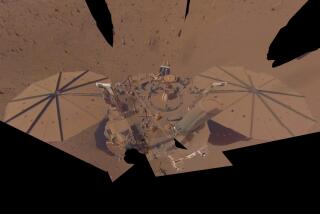More Clues of Mars’ Watery Past
- Share via
The first chemical analysis of the tiny spherules of rock called Martian blueberries shows that they are composed of iron-bearing hematite -- a finding that provides yet another piece of evidence that large quantities of water once existed on the planet.
Spectrometers on Mars orbiters had observed vast fields of hematite at Meridiani Planum, stretching over an area the size of Oklahoma. The rover Opportunity landed there Jan. 24 to find the source.
The team has now concluded that the hematite, a mineral typically formed in water, is in the blueberries.
Researchers at Pasadena’s Jet Propulsion Laboratory have now concluded that the blueberries were formed by water percolating through sedimentary layers of Martian soil, geologist Andrew Knoll of Harvard University, a member of the rover science team, said Thursday.
The team thinks that once Opportunity gets out of the small crater it landed in, it will find the blueberries scattered across the entire surface of Meridiani Planum.
“A pretty good science story has now fallen into place,” Knoll said. “This is a story of rock-water interactions, of the diffusion of chemicals through [large quantities of] water.”
The presence of hematite at Meridiani Planum was confirmed by instruments on Opportunity shortly after it landed.
But geologists had a difficult time determining exactly which portion of the complex Martian soil contained the crucial mineral. Their primary tool for identifying hematite in rock is a Mossbauer spectrometer, but the detection head on the instrument is much larger than the small blueberries. Any signal from a single blueberry, therefore, is overwhelmed by the signal from the soil behind it.
To get around this problem, the team drove Opportunity to a site known as Blueberry Bowl, where several spherules were concentrated in a small area. Using the Mossbauer spectro- meter, they analyzed the composition of Blueberry Bowl and compared it to that of nearby soil that contained no blueberries.
Their conclusion: “The major iron-bearing mineral in the blueberries is hematite,” said geologist Daniel Rodionov of the University of Mainz in Germany, where the Mossbauer instrument was built.
Spherules like the blueberries generally have one of three origins: They can be produced from tiny drops of liquid rock ejected from a volcano, they can be produced from tiny drops of liquid rock flung through the air by a meteor impact, or they can be formed in water through a process known as concretion.
Such concretions are formed when dissolved minerals in water precipitate out around a microscopic nucleus, eventually growing into spherical rocks. The physical evidence on Mars indicates this is how the blueberries were formed, Knoll said.
The most obvious evidence is that the blueberries are scattered “willy-nilly” throughout the rock outcropping, Knoll said. If they had been formed from flying rock, they would have formed in one or more single events and would have accumulated in distinct layers between the sedimentary layers of the background rock.
Furthermore, when the team observed blueberries still embedded in the rock outcropping, they found that layers of the rock “go right into the berry, they don’t deform around it,” Knoll said. That means they were formed after the rock.
The team has also found examples where two or more blueberries have grown together, which would not have happened if they formed from liquid rock.
All this evidence indicates that “the blueberries are concretions that grew within the sediment at Meridiani,” Knoll said. And that means, in turn, that there was once a significant quantity of water in the soil.
The rover team already had concluded that large amounts of water had once been present at Meridiani. The team announced two weeks ago that the rock outcropping was “full of sulfate salts,” which are generally considered a telltale sign of water.
The new findings confirm that conclusion.
Halfway around Mars, meanwhile, the rover Spirit, which landed Jan. 3, has been perched on the rim of Bonneville crater taking high-resolution images of the interior. “But we haven’t found anything enticing enough to make us want to go down into the crater,” said mission manager Mark Adler.
Instead, sometime over the weekend Spirit will finally head off toward the Columbia Hills to the southeast, a journey that could take several months.
The team did find one unusual feature in the photos taken by Spirit, said Albert Haldeman, deputy project scientist. Over the opposite rim of Bonneville crater, the photos show the rim of Gusev Crater, the much larger crater that contains Bonneville.
That rim is about 50 miles away, Haldeman said. The fact that the rover could see it, despite the dust in the Martian atmosphere, indicates that the air on Mars “is clearer during the day than it is in Los Angeles.”






